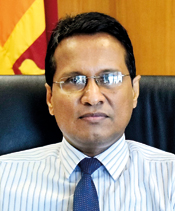SEC-CSE joint committee draws up digitisation master plan

Viraj Dayaratne
This time the capital market just cannot go wrong. The Securities and Exchange Commission (SEC) has got a gamut of proposals to relieve the market from its current brittle state and the new chief is determined to see them to fruition.
A joint committee of the SEC and the Colombo Stock Exchange (CSE) on Wednesday submitted to the SEC a master plan to digitise the end-to-end functions of the exchange in a bid to avoid disastrous closures of the market as what was experienced in the 51-day shutdown.
SEC Chairman Viraj Dayaratne, PC last month appointed this joint committee of the SEC and CSE to digitise all core activities of the stock market and to have measures in place to ensure electronic clearing and settlement.
Called the “Committee on Digitalisation of the CSE”, it will work towards digitising all functions of the CSE and assisting custodian banks to make affirmations on trading on T+1 while helping stockbrokers digitise all their core functions, Mr. Dayaratne told the Business Times in an interview on Wednesday. This will digitise the exchange in total so should another curfew come, the CSE can function smoothly.
The committee submitted the proposals and it was finalised on Wednesday. Mr. Dayaratne added that timelines and milestones to complete digitising were arrived at and it’ll happen sooner than later.
This is apart from another similar joint committee to broadbase the CSE through education and awareness that was formed on May 15 aimed at additional things the SEC and CSE can do in this regard.
Mr. Dayaratne said both these committees were a culmination of what happened from March 20 to May 13 – from when the CSE closed to two days after it opened.
It made history as the only exchange which traded for the shortest time – 52 minutes –on May 11, the first day of trading after shutdown when liquid share index, S&P SL 20 plunged more than 10 per cent due to intense selling with stock prices falling by 10 per cent. The next day it faced a circuit breaker after nine minutes after the S&P SL 20 plunged more than 10 per cent due to intense selling. The regulator was criticised for not opening the CSE sooner.
He said this couldn’t have happened at the time as it wouldn’t have been a fair and orderly market. “I asked the CSE to identify operational aspects if the market was to function. It was said that the CSE should be classified as an essential service so stakeholders are mobile. So I wrote to the Treasury of this possibility but at the time they were unable to do so due to health concerns as gatherings were what they wanted to ban to stop the spread of COVID-19.”
As Sri Lanka’s electronic trading is only 25 to 30 per cent of the total traders it won’t be fair to call for Internet trading, he added. In this situation, even though the CSE is keen to resume trading, it was not ‘ready’, Mr. Dayaratne stressed.
He said that foreign outflow was not a good thing, but the market forces have to be in control which is what happened at the start of the trading on May 11. “But now it is settling down. The idea to have new circuit breakers helped contain the free fall of the market on the first and second days,” he explained.
Mr. Dayaratne has plans to meet with more stakeholders in the months to come to have a better functioning market with their inputs. “I already met many and was to meet others when the shutdown happened. But the SEC will call for more sit-downs now that curfew seems to be easing.”



